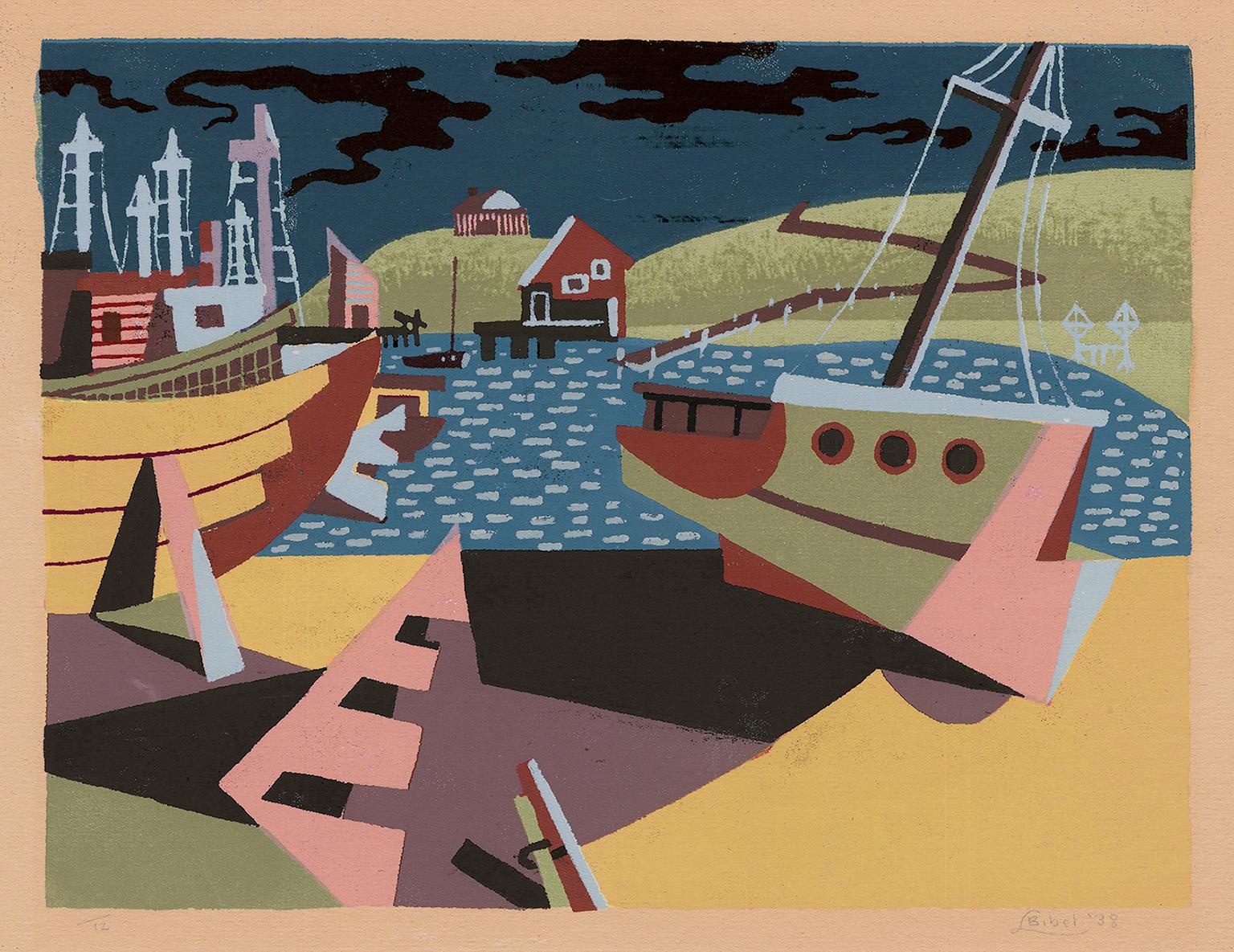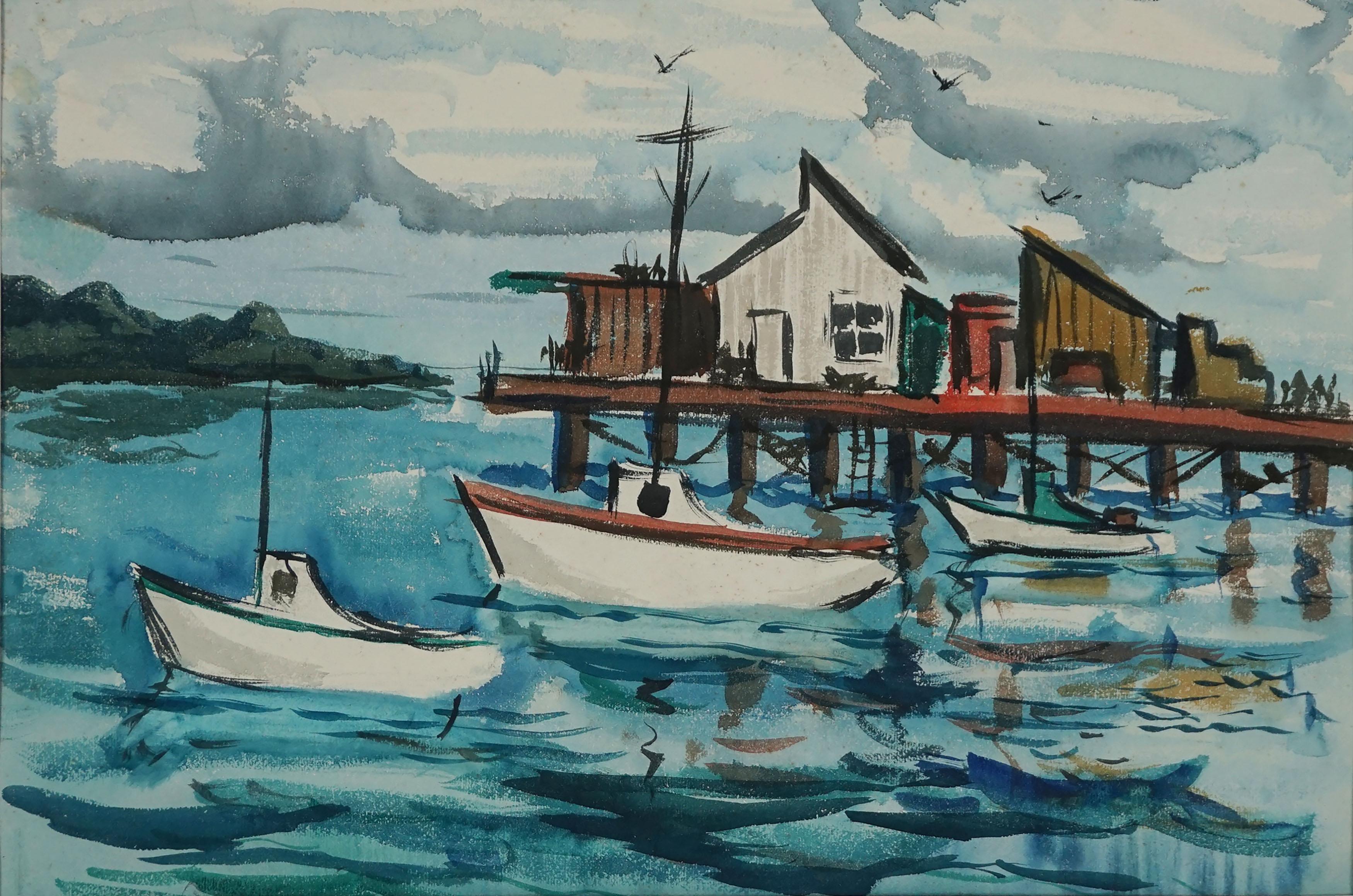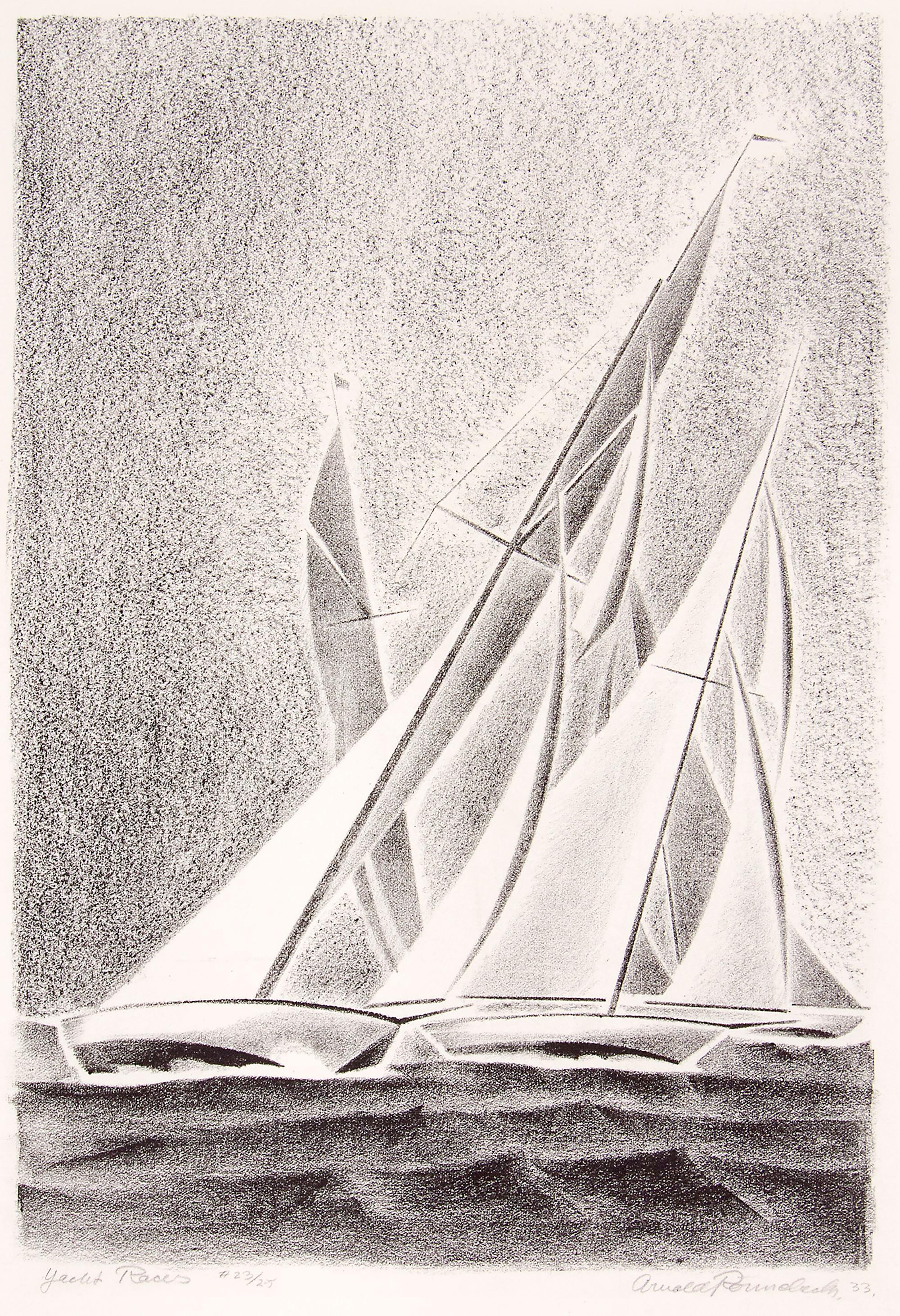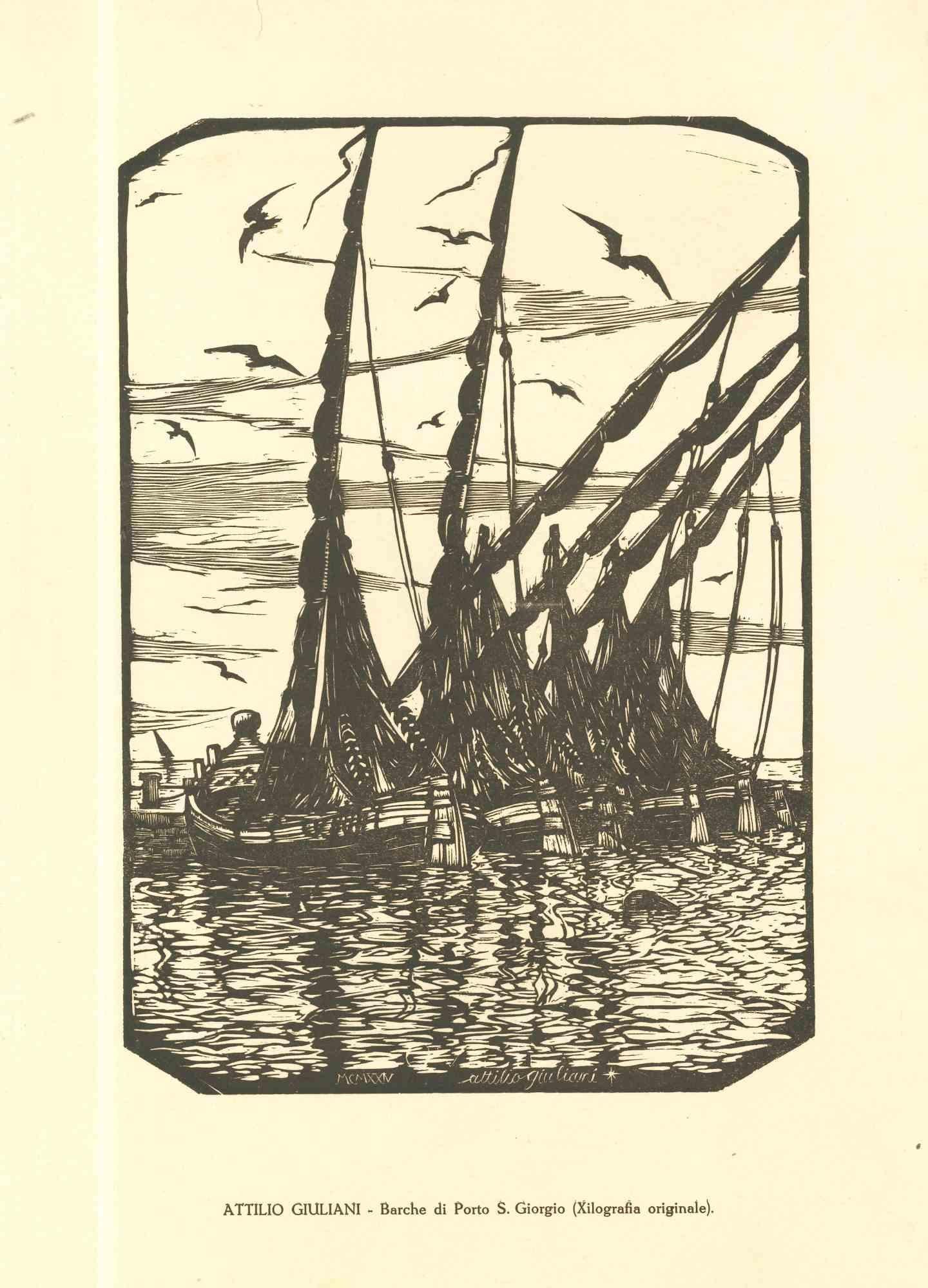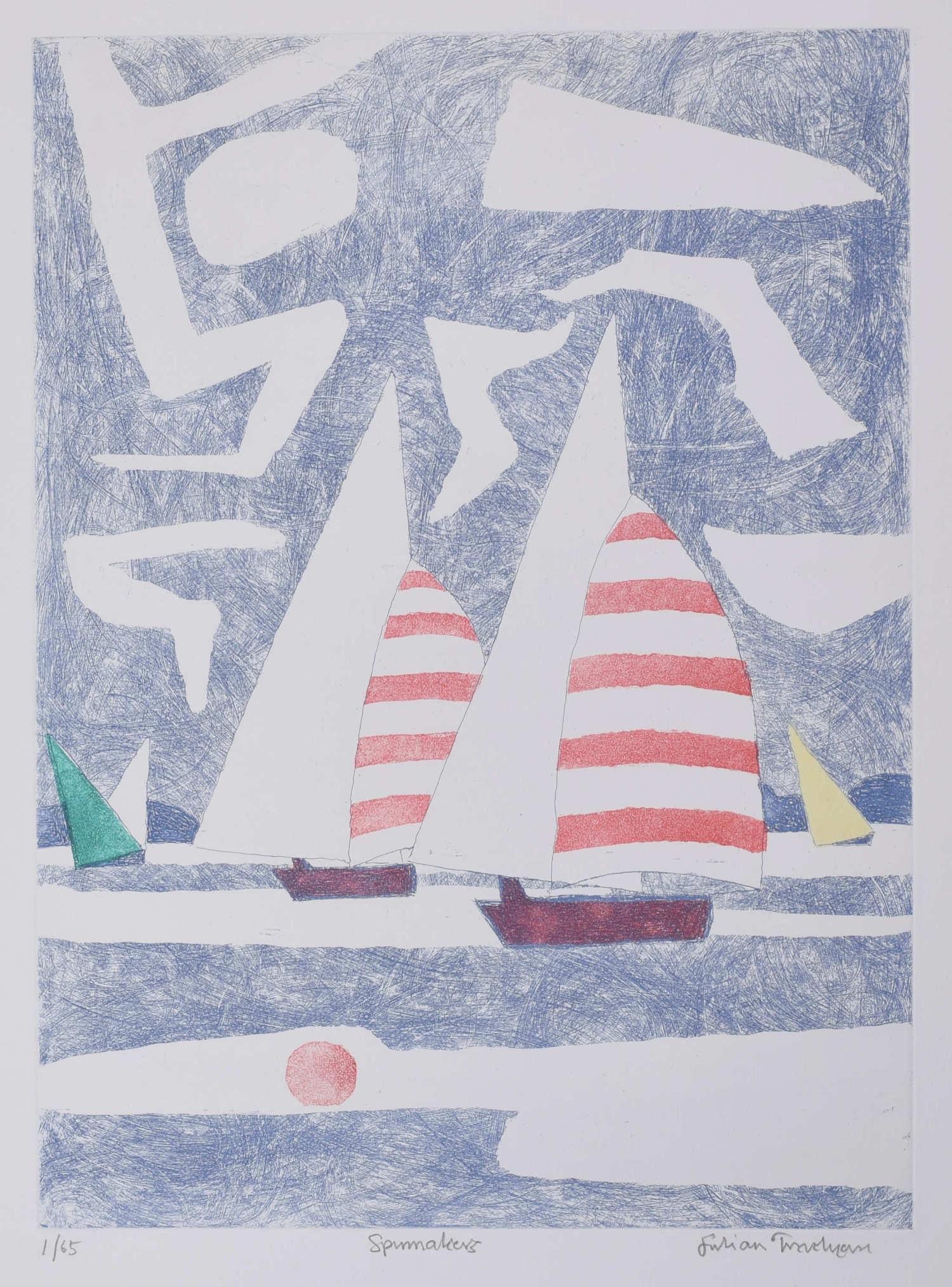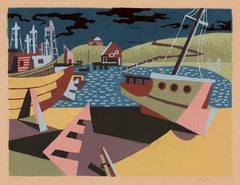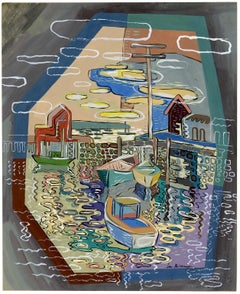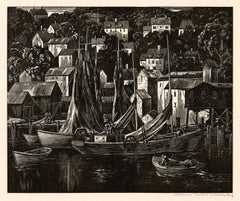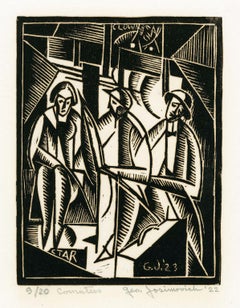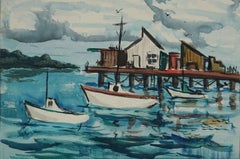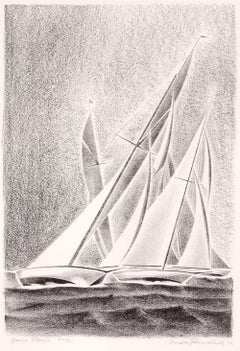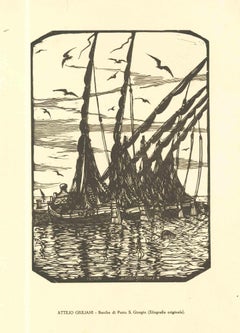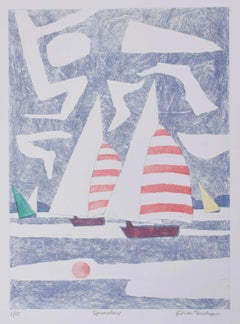Items Similar to Harbor with Sailboats — Early 20th-Century Modernism
Want more images or videos?
Request additional images or videos from the seller
1 of 3
George JosimovichHarbor with Sailboats — Early 20th-Century Modernism1923
1923
$2,400
£1,830.55
€2,084.56
CA$3,372.73
A$3,678.44
CHF 1,948.59
MX$44,099.25
NOK 24,816.36
SEK 22,692.72
DKK 15,573.69
About the Item
George Josimovich, Untitled (Harbor with Sailboats) ', linocut, 1923, edition 35. Signed, dated, and annotated '4/35' in pencil. Initialed 'G J' in the matrix, lower left. A fine, richly-inked impression, on cream wove Japan paper, with full margins (7/8 to 2 3/4 inches), in excellent condition. Scarce. Image size 9 x 8 inches (225 x 203 mm); sheet size 14 1/2 x 10 3/4 inches (368 x 273 mm). Matted to museum standards, unframed.
“Life is in a constant state of flux-never-ceasing motion. Everything breathes, moves, vibrates. And it is my ardent belief that the same should be true in a work of art. It should be alive, dynamically alive. Every part of it should live and every part of it should contribute life to the creation as a whole. ...anyone who is sensitive and creative enough to deserve to be called an artist will consciously or unconsciously react to...those phases of life with which his particular nature and personality have a special kinship. And all this cannot help but leave an impress upon his work which is and must be, if it is sincere, an objective manifestation of his inner self.” —George Josimovich, Illinois Historical Art Project
ABOUT THE ARTIST
Born in Mitrovica, Yugoslavia (present-day Serbia), George Josimovich (1894 - 1986) immigrated to the United States with his parents and three younger brothers in 1908. The family settled in Fort Laramie and Cheyenne, Wyoming, along the Union Pacific Railroad, where his father worked as a tailor. In 1914, motivated by a newspaper advertisement for the Lockwood Art School in Kalamazoo, Michigan, Josimovich set out for the Midwest to pursue a career in art.
From 1914–19 he studied at the School of the Art Institute of Chicago (SAIC) under Karl Buehr and Randall Davey, and alongside fellow students William Schwartz, Emil Armin, and Archibald J. Motley Jr. During his final year at SAIC, Josimovich enrolled in a life class with visiting professor George Bellows, whose teachings about avant-garde art, geometric composition, color theory, and individualism in art exerted a profound influence. An exhibition of applied arts by German artist Hermann Sachs at the Art Institute of Chicago during the winter of 1920–21 also made a strong impression on the young artist. Josimovich studied under Sachs at Chicago’s Hull House and, along with other former SAIC students, followed Sachs to the Dayton Art Museum in Ohio to establish an expressionist craft program.
Josimovich returned to Chicago in 1922, where he joined the Jackson Park art colony and spent the next four years honing his craft and developing theories on composition and form. His works from this period evince a lively experimentation with modernist principles and techniques in oil and watercolor paintings, prints, and drawings. Familiar genres of figure study, still life, and landscape are distilled into abstract arrangements of fragmented forms in radically flattened pictorial space, often within tightly ordered geometric compositions. Throughout the 1920s Josimovich established himself as a leading contemporary artist in the city, exhibiting with the Chicago No-Jury Society of Artists, The Ten, and the Chicago Society of Artists, where he later served as president. Critics lauded him as quintessentially modern, praising his “rigid intellectualism” and his focus on color, form, and movement. Josimovich’s year in Paris in 1926–27, where he encountered other practitioners of abstraction and the theory of purism, further stimulated his modernist approach to art. His French sojourn culminated in a 1927 solo exhibition at the Galerie d’art contemporain in Paris, which garnered much coverage in the press.
In the 1930s, Josimovich dramatically transformed his art and became an expressionist in the vein of French painter Chaim Soutine. Soutine, who had emigrated to Paris in 1913 from Belarus, rose to international prominence through a major show at the gallery of Paul Guillaume in 1923 and subsequent purchases of his work by American collector Albert Barnes. Josimovich’s portraits, still lifes, and landscapes from this period bear some of the hallmarks of Soutine’s work in their exaggerated figures, quivering masses of color, and dynamic brushstrokes, and as a result, sparked strongly divided commentary among Chicago critics.
In the early 1930s, Josimovich was one of the organizers of the Fifty-seventh Street Art Colony, a group of artists with modernist sympathies, and worked briefly for the artists’ relief program of the Works Progress Administration. He continued to show his work through the 1950s in numerous group exhibitions at the Art Institute of Chicago, with the No-Jury Society of Artists and the Chicago Society of Artists, and in a solo exhibition at Knoedler’s Chicago gallery in 1932.
—edited from an essay by Patricia Smith Scanlan for ‘Modernism in the New City, Chicago Artists, 1920-1950’
- Creator:George Josimovich (1894 - 1986)
- Creation Year:1923
- Dimensions:Height: 9 in (22.86 cm)Width: 8 in (20.32 cm)
- Medium:
- Movement & Style:
- Period:
- Condition:
- Gallery Location:Myrtle Beach, SC
- Reference Number:Seller: 1038901stDibs: LU53239004692
About the Seller
5.0
Recognized Seller
These prestigious sellers are industry leaders and represent the highest echelon for item quality and design.
Platinum Seller
Premium sellers with a 4.7+ rating and 24-hour response times
Established in 1995
1stDibs seller since 2016
334 sales on 1stDibs
Typical response time: 1 hour
Associations
International Fine Print Dealers Association
- ShippingRetrieving quote...Shipping from: Myrtle Beach, SC
- Return Policy
More From This Seller
View All'Abstract Boats' — American Modernism, WPA
By Leon Bibel
Located in Myrtle Beach, SC
Leon Bibel, 'Abstract Boats', color serigraph, 1938, edition 12. Signed, dated, and numbered ' /12' in pencil. A fine, painterly impression, with fresh colors, on buff wove paper; t...
Category
1930s American Modern Figurative Prints
Materials
Screen
'Rockport Harbor' — Mid-Century Modernism
By Louis Wolchonok
Located in Myrtle Beach, SC
Louis Wolchonok, 'Rockport Harbor', gouache, c. 1950. Signed in ink, lower right. A fine, modernist work, with fresh colors, on cream wove drawing pape...
Category
1950s American Modern Abstract Drawings and Watercolors
Materials
Gouache
Tranquil Harbor (Gloucester, Massachusetts) — 1950s Cape Ann Regionalism
By Lawrence Wilbur
Located in Myrtle Beach, SC
Lawrence Nelson Wilbur (1897-1988), 'Tranquil Harbor' (Gloucester, Massachusetts), wood engraving, edition 55, 1958. Signed in pencil, and signe...
Category
1950s American Modern Landscape Prints
Materials
Woodcut
'Commuters' — Early 20th-Century Modernism
By George Josimovich
Located in Myrtle Beach, SC
George Josimovich, 'Commuters', linocut, 1922-23, edition 20. Signed, dated '22, titled, and annotated '9/20' in pencil. Initialed in the block 'G.J....
Category
1920s American Modern Figurative Prints
Materials
Linocut
'Sailing' — Modernism, New York City WPA
Located in Myrtle Beach, SC
Fred Becker, 'Sailing', wood engraving, c. 1935, edition c. 25. Signed and titled in pencil. A fine, richly-inked impression, on off-white wove paper; with full margins (1 to 2 15/16...
Category
1930s Modern Figurative Prints
Materials
Woodcut
New Rochelle - Before the Wind
By Werner Drewes
Located in Myrtle Beach, SC
'New Rochelle - Before the Wind', drypoint, 1931, edition 30 (only a few impressions printed), Rose l.163. Signed, dated '1932' and numbered '1 – XXX' in ...
Category
1930s Modern Figurative Prints
Materials
Drypoint
You May Also Like
Mid Century Modern Nautical Landscape - Sailboats by the Wharf
Located in Soquel, CA
Mid Century Modern Nautica Landscape of Boats and Wharf in Acrylic on Paper
Vibrant mid century landscape by California artist Bertram Spencer (American, 1918-1992). Three sailboats...
Category
Mid-20th Century Contemporary Landscape Paintings
Materials
Watercolor, Laid Paper
$1,000 Sale Price
20% Off
1933 Black & White Lithograph of Yacht Races on Grand Lake, Colorado, Sailboats
By Arnold Rönnebeck
Located in Denver, CO
A rare and striking original 1933 black and white lithograph by noted modernist Arnold Rönnebeck (1885–1947), titled Yacht Races, Grand Lake, Colorado. This limited-edition coastal a...
Category
1930s American Modern Prints and Multiples
Materials
Lithograph
Boats - Original Woodcut by Attilio Giuliani - 1924
By Attilio Giuliani
Located in Roma, IT
Boats in Porto San Giorgio is an original woodcut print realized by Attilio Giuliani in 1924.
Signed and dated on plate. The artwork depicts a scene from the habour of Porto San Gio...
Category
1920s Modern Figurative Prints
Materials
Woodcut
Julian Trevelyan: 'Spinnakers' sailing boats Modern British Art print
By Julian Trevelyan
Located in London, GB
We have seven of Julian Trevelyan's prints, and oil paintings by him - and other Modern British Artists. To see the others, scroll down to "More from this Seller" and below it click on "See all from this Seller" and search for "Trevelyan".
Julian Trevelyan (1910-1988)
Spinnakers
Etching
48 x 35 cm (sheet size 68 x 55 cm)
Signed in pencil and numbered 1/65.
The Tate holds number 24/56 - reference P01330.
Small vessels weave around two great boats with striped masts, observed by a dark sky full of geometric clouds. A red buoy...
Category
20th Century Modern Figurative Prints
Materials
Etching
Brittany : Boats at the Harbour - Original wooodcut, Handsigned
By René Quillivic
Located in Paris, IDF
René Quillivic
Brittany : Boats at the Harbour, 1923
Original woodcut
Handsigned in pencil
Numbered /154
On vellum 32.5 x 25.5 cm (c. 13 x 10 in)
Bears...
Category
1920s Modern Landscape Prints
Materials
Woodcut
Harborfront, American Impressionist, 20th Century, Wooden Sailing Ships at Dock
Located in Wiscasset, ME
In "Harborfront" the artist uses colorful, impressionist brushstrokes to bring a working waterfront to life.
Category
20th Century American Impressionist Landscape Paintings
Materials
Canvas, Oil, Board
